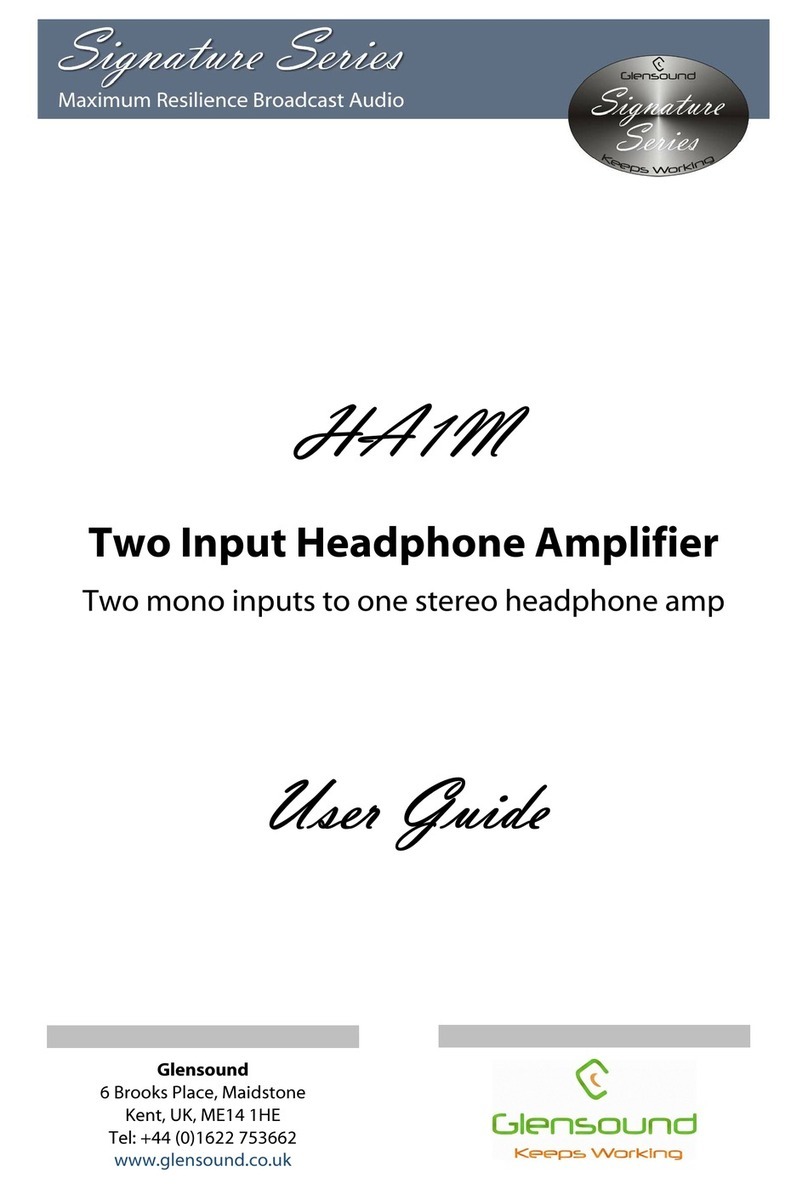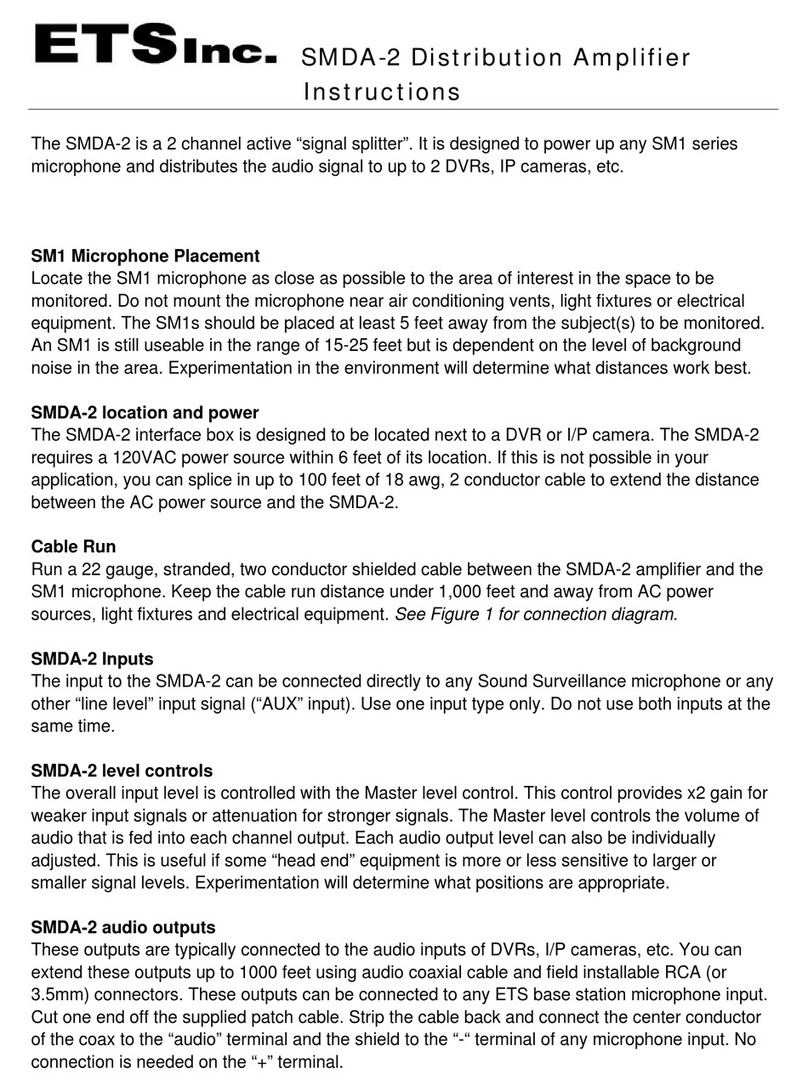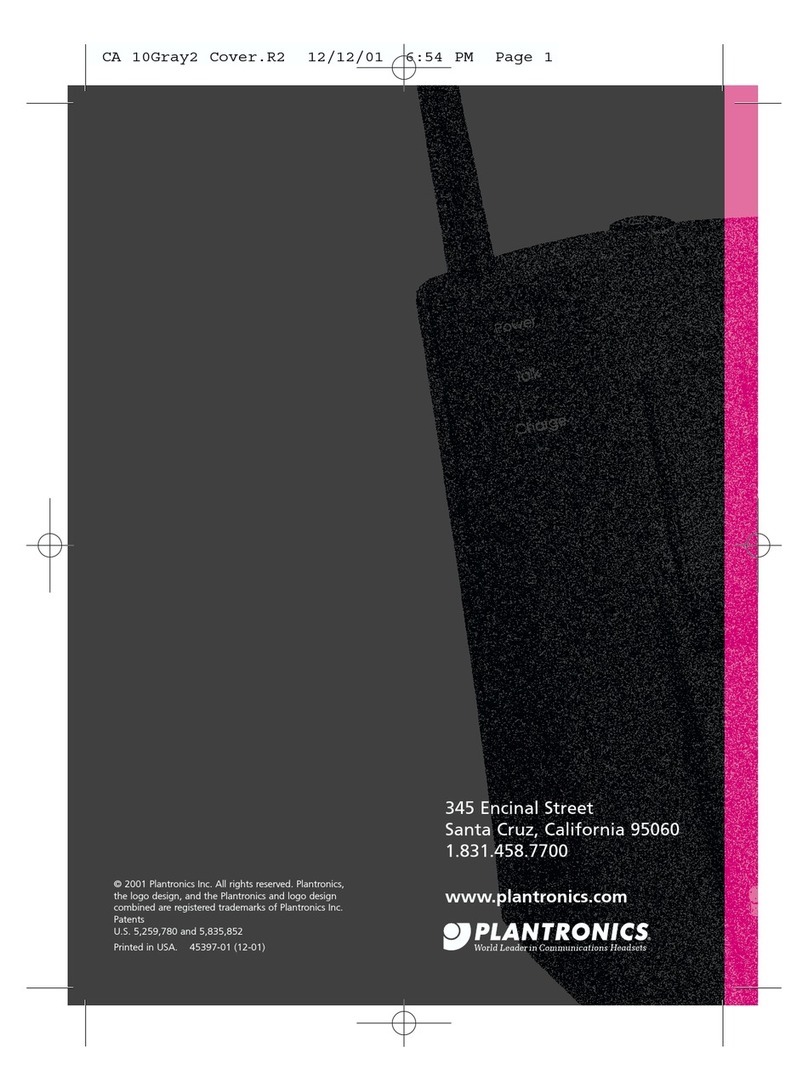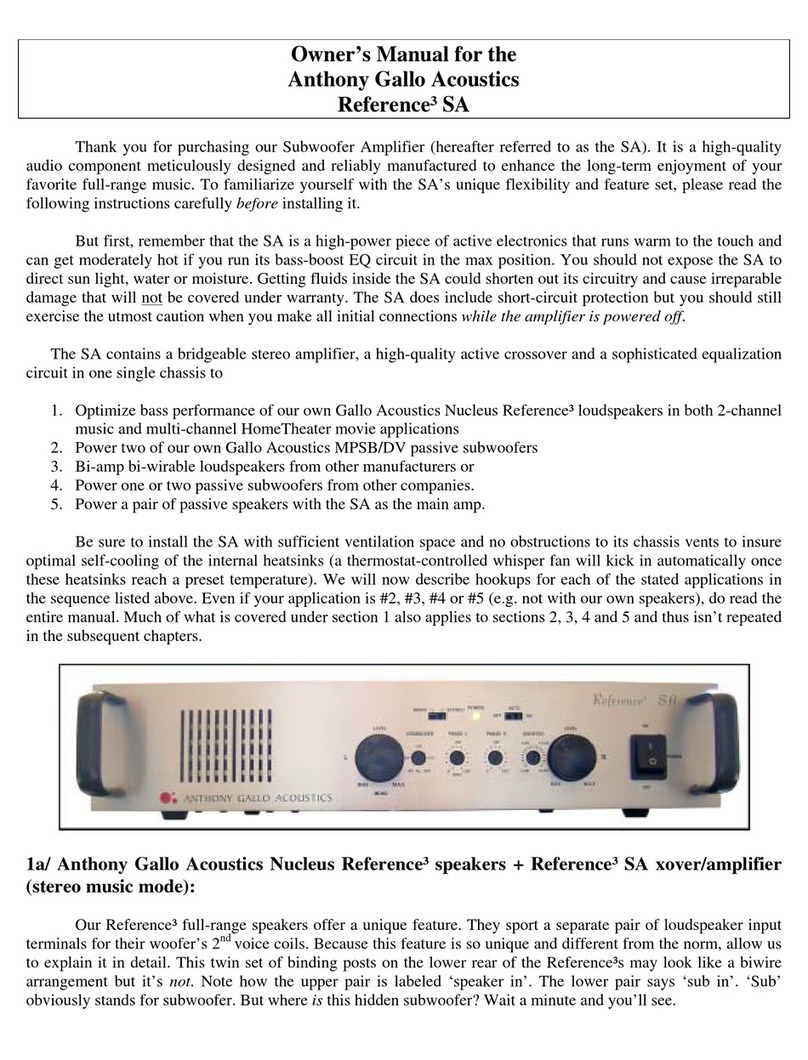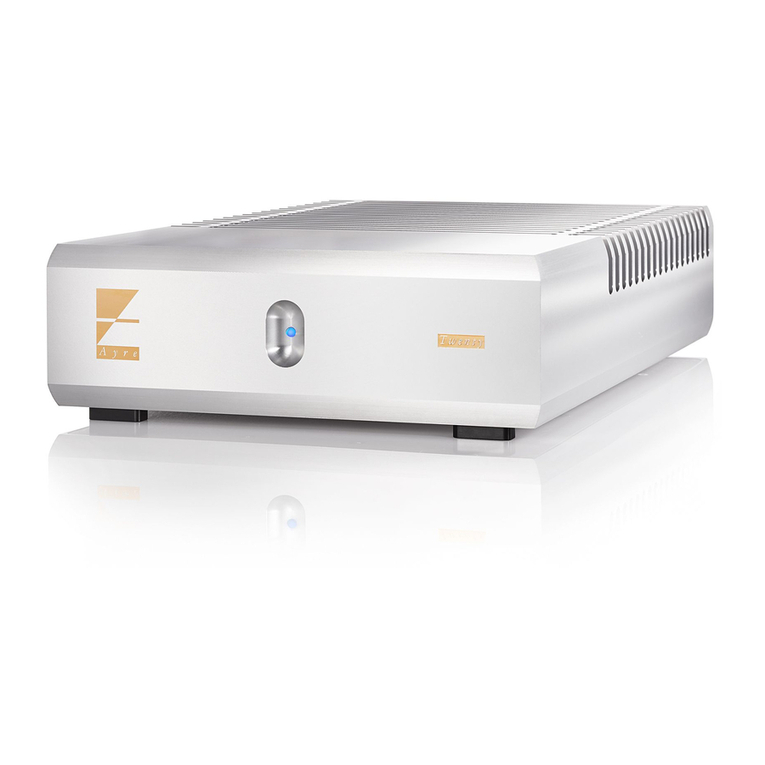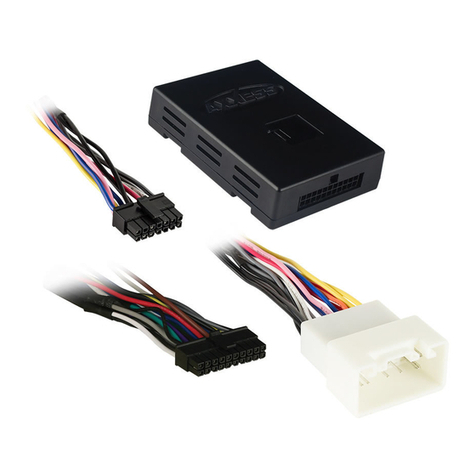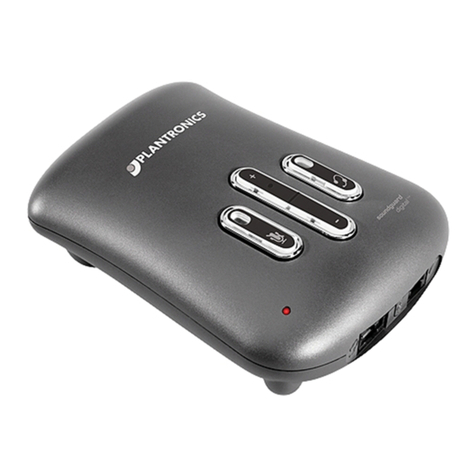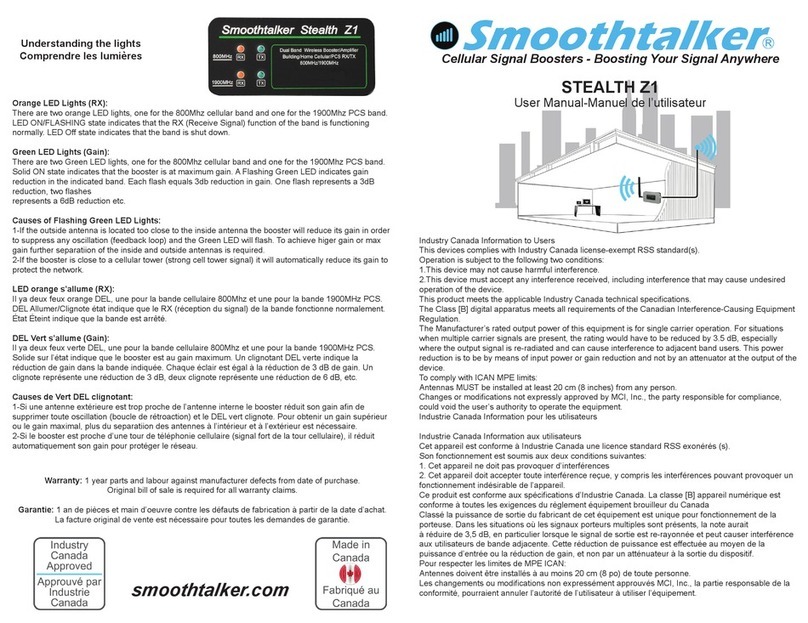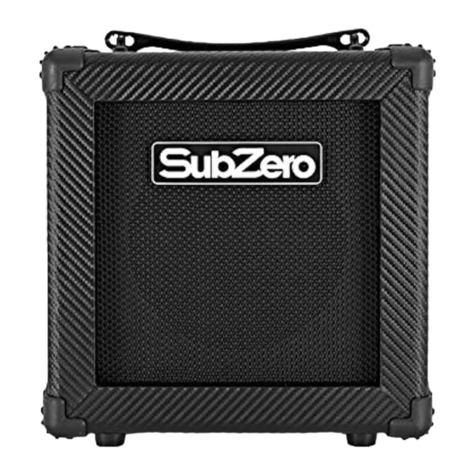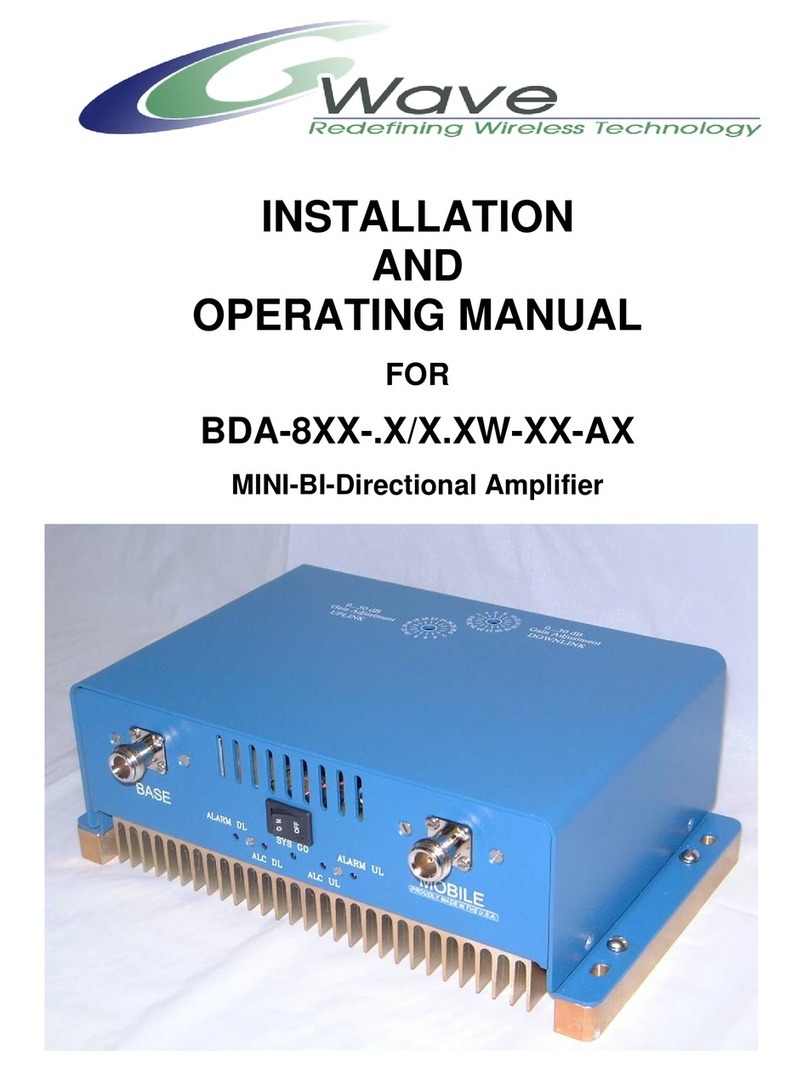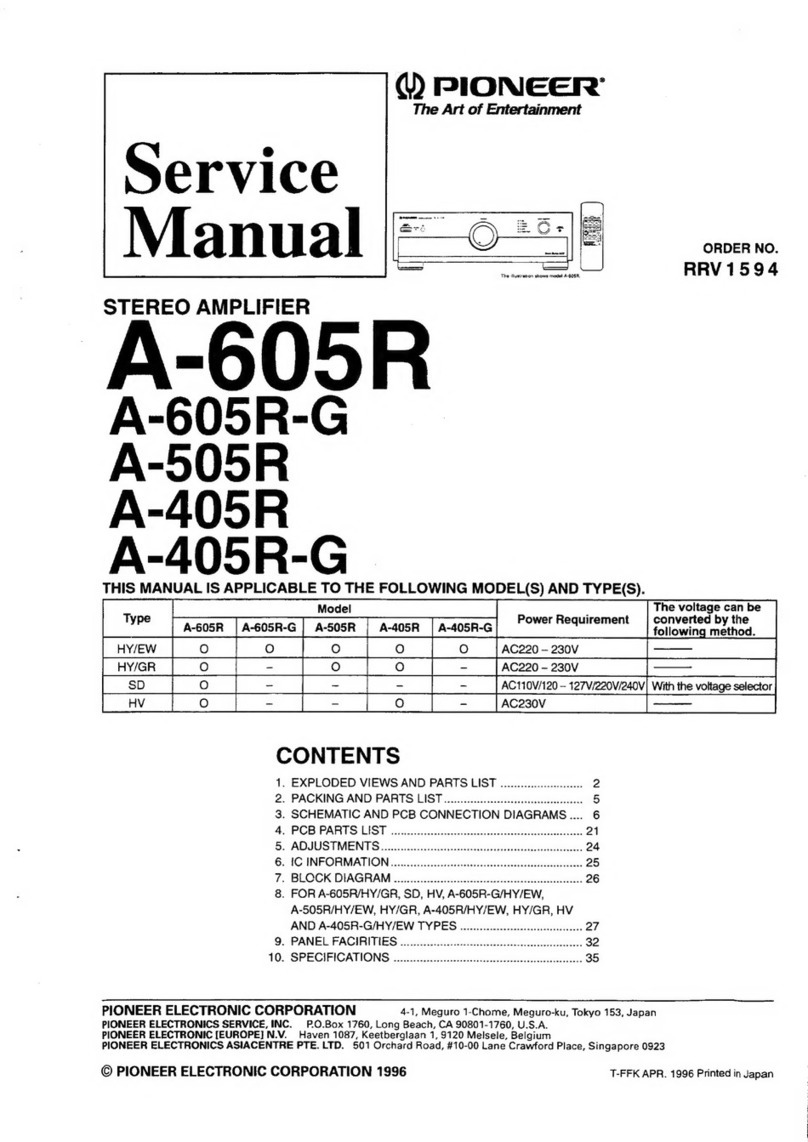Gilderfluke & Co Amp-50 Quick guide

Amp-50 Configuration & Installation
Before the Amp-50 can be used, you will need to attach speakers, power supply and a line
level audio source.
Speaker Outputs:
The Amp-50 is a ‘Class-
D’ design. Its efficiency is
near 90%. If you feed 50
Watts of 24 vdc into the
Amp-50’s amplifier, you
will get almost 50 Watts
into your speakers. ‘Lin-
ear’ amplifiers have only
about 20% efficiency.
Fully 80% of the power
you put into them goes
into the heatsink as waste
heat. A 50 Watt linear
amplifier would only feed
10 Watts of power into
your speakers, and 40
Watts into the heatsink.
This makes the Amp-
50’s amplifier roughly
equivalent to what
would be a 200 Watt
linear amplifier!
If you are going to run
your speakers at high
SPLs, you will need to select speakers that can
handle at least a 100 Watts or more continuous
power. Smaller speakers may clip or be damaged if
run at too high an output power level from the Amp-
50.
The amplifier outputs from the Amp-50 can be used
with speakers of four to eight ohms impedance. As
with any amplifier, you can series/parallel any num-
ber of speakers, so long as the impedance remains
within limits.
The Amp-50 is well protected from short circuits and
overheating. You can stick a screwdriver right
across the speaker terminals! The Amp-50 will go
back to work a moment after a fault is removed. If
the speaker impedance is too low and you are run-
ning at a high volume level, the amplifier may start
to cut out. If you hear this, check the power supply
voltage. If the input voltage is dropping, you might
simply be drawing too much power for the power
supply and a larger supply may fix your problem. If
the power supply is OK, and you can’t increase the
speaker impedance, then you might simply be ask-
ing too much of the Amp-50’s amplifier, and need to
turn down the volume a tad.
To comply with FCC and CE standards for radio fre-
quency emissions, you should use conduit or
shielded speaker wires with the Amp-50. The shield
should be attached to the power supply ‘negative’
terminal, which is immediately adjacent to the
speaker terminals. Shielding the speaker lines will
not affect the sound quality from the Amp-50, but
will make the FCC and CE folks happy. Shielded
speaker lines were used during all CE/FCC certifica-
tion testing.
Bridged Amplifier: If you need
a mono output with more
‘oomph’, the Amp-50 can be
‘bridged’. Bridging will
only have an effect with
lower impedance speak-
ers You won’t hear a bit
of difference if you are
using an eight ohm
speaker. The only audio
which is amplified comes
from the ‘left’ input. The
wiring to ‘bridge’ the am-
plifier is a little different
than on a linear amplifier.
The speaker is wired in
parallel to both right and
left speaker outputs, and
the jumper inside the Amp-
50 is moved to the ‘bridged’ posi-
tion. Wiring the speakers for a
‘bridged’ output with-
out moving this
jumper can damage
the Amp-50.
Gilderfluke & Co.•205 South Flower Street •Burbank, California 91502 •818/840–9484 •800/776–5972 •fax 818/840–9485
East Coast/Florida Office •7041 Grand National Drive •Suite 128d •Orlando, Fl. 32819 •407/354–5954 •fax 407/354–5955
page 1 of 3 • © February 9, 2007 Gilderfluke & Co. DCM
Amp-50
Gilderfluke & Company
Burbank, California
Left Right
Line In Line In VolumeVolume
Right Left
12-24 vdc
Power
(4Ωto 8Ω)
Speakers
Line Level
Source
Amp-50
Gilderfluke & Company
Burbank, California
Left Right
Line In Line In VolumeVolume
Right Left
12-24 vdc
Power
(4Ωto 8Ω)
Speakers
Line Level
Source

Line Level Inputs:
Two RCA line level inputs are available on the Amp-
50s. A line level audio signal from a Sd-10 audio re-
peater, pre-amplified microphone, CD player, Video
projector, or any other line-level audio source can be
plugged into these two RCA jacks. Two trimpots can
be used to adjust the levels of the mixer inputs.
Power Supply:
The Amp-50 will run on any voltage from 12 through
24 vdc. Size your power supply so it will provide
enough current for the volume you are planning to
run at. The amplifier will put out more power at 24
volts than it can at a lower voltage. If using all 50
Watts of the amplifier power, you will need to use a
24 volt supply rated at least 60 Watts. If you hear
clipping, the speakers or power supply may be un-
dersized for your application.
The power supply can be attached through the 2.1
mm power jack, or the screw terminals. Power Sup-
ply voltages higher than 24 vdc can damage the
amplifier on the Amp-50.
Volume Controls:
A pair of small trimpots on the Amp-50 are used to
set the audio output level. You can adjust these pots
using a small ‘trimmer’ screwdriver.
These trimpots are smaller than you. Do not use a
big screwdriver on them. Do not apply too much
force. They will break!
Amp-50 Installation:
The Amp-50 can be mounted using two screws;
DIN rail adapters; 2–3/4” Augat ‘Snap-Track’ (which
itself can be DIN rail mounted using DIN rail adapt-
ers); or just Velcro’d down. In many applications, the
Amp-50 can be attached on (or in) the speakers it is
feeding. The Amp-50 must not be mounted where it
might get wet, or suffer from extremes of tempera-
ture.
Unless the amplifier is being run at extreme output
levels, the Amp-50 will generate very little heat. At-
taching it to something metal will allow it to dissipate
what little heat it does generate.
Gilderfluke & Co.•205 South Flower Street •Burbank, California 91502 •818/840–9484 •800/776–5972 •fax 818/840–9485
East Coast/Florida Office •7041 Grand National Drive •Suite 128d •Orlando, Fl. 32819 •407/354–5954 •fax 407/354–5955
page 2 of 3 • © February 9, 2007 Gilderfluke & Co. DCM
2.75"
2.00"
1.30"
Amp-50
Gilderfluke & Company
Burbank, California
Left Right
Line In Line In VolumeVolume
Right Left
12-24 vdc
Power
(4Ωto 8Ω)
Speakers
This device complies with Part 15 of the FCC rules.
Operation is subject to the following two conditions: (1) This
device may not cause harmful interference and (2) this
device must accept any interference received, including
interference that may cause undesired operation.
This Class B digital apparatus meets all
requirements of the Canadian Interference-
Causing Equipment Regulations.
Cet appareil numerique de la classe B respecte
toutes les exigences du Reglement sur le materiel
brouilleur du Canada.

FCC and CE Compliance:
Amp-50s have been tested to comply with FCC and CE re-
quirements.
Because Amp-50s are low voltage DC devices, neither UL or
CE require safety testing.
For fireproofing or additional radio frequency interference
shielding, Amp-50s can be mounted in a fire rated metallic
case. Typically, this would be a NEMA-rated electrical enclo-
sure or 19” electrical rack.
FCC Instruction to User:
This equipment has been tested and found to comply with the
limits for a class B digital device, pursuant to part 15 of the
FCC Rules. These limits are designed to provide reasonable
protection against harmful interference in a residential installa-
tion. This equipment generates, uses and can radiate radio
frequency energy and if not installed and used in accordance
with the instructions, may cause harmful interference to radio
communications. However, there is no guarantee that interfer-
ence will not occur in a particular installation. If this equipment
does cause harmful interference to radio or television recep-
tion, which can be determined by turning the equipment off and
on, the user is encouraged to try to correct the interference by
one or more of the following measures:
•Reorient or relocate the receiving antenna.
•Increase the separation between the equipment and re-
ceiver.
•Connect the equipment into an outlet on a circuit different
from that to which the receiver is connected.
•Consult the dealer or an experienced radio/TV technician for
help.
This equipment has been verified to comply with the limits for a
class B computing device, pursuant to FCC Rules. In order to
maintain compliance with FCC regulations, shielded cables
must be used with this equipment. Operation with non-
approved equipment or unshielded cables is likely to result in
interference to radio and TV reception. The user is cautioned
that changes and modifications made to the equipment without
the approval of manufacturer could void the user's authority to
operate this equipment.
This device complies with Part 15 of the FCC
Rules. Operation is subject to the following two
conditions: (1) This device may not cause harmful
interference and (2) this device must accept any
interference received, including interference that
may cause undesired operation.
This Class B digital apparatus meets all require-
ments of the Canadian Interference-Causing
Equipment Regulations.
Cet appareil numerique de la classe B respecte
toutes les exigences du Reglement sur le
materiel brouilleur du Canada.
EC DECLARATION OF CONFORMITY
Friday, February 9, 2007
Application of Council Directives:!!!!EMC Directive, 89/336/EEC
Manufacturer's Name:!!!!!Gilderfluke & Co., Inc.
Manufacturer’s Address:!!!!!205 South Flower St., Burbank, California 91502 USA
Importer’s Name:!!!!!!!!!!!!!
Importer’s Address:!!!!!!!!!!!!!
Type of Equipment:!!!!!!Professional Audio
Equipment Class:!!!!!!Commercial and Light Industrial
Model:!!!!!!!Amp-50
Conforms to the following Standards:!!!EN 55103–1: 1996 and EN 55103–2: 1996
Year of Manufacture:!!!!!2006
I the undersigned, hereby declare that the equipment specified above conforms to the above directive(s)
and standard(s).
Place:!Burbank, California!!!!!Signature:!(signed)! ! ! !
Date: August 1, 2006!!!!!Full Name:!Doug Mobley
!!!!!!!!Position:!CEO
Gilderfluke & Co.•205 South Flower Street •Burbank, California 91502 •818/840–9484 •800/776–5972 •fax 818/840–9485
East Coast/Florida Office •7041 Grand National Drive •Suite 128d •Orlando, Fl. 32819 •407/354–5954 •fax 407/354–5955
page 3 of 3 • © February 9, 2007 Gilderfluke & Co. DCM
Table of contents
